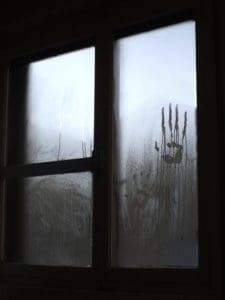International Versions of the Evil Eye Myth: A Global Perspective
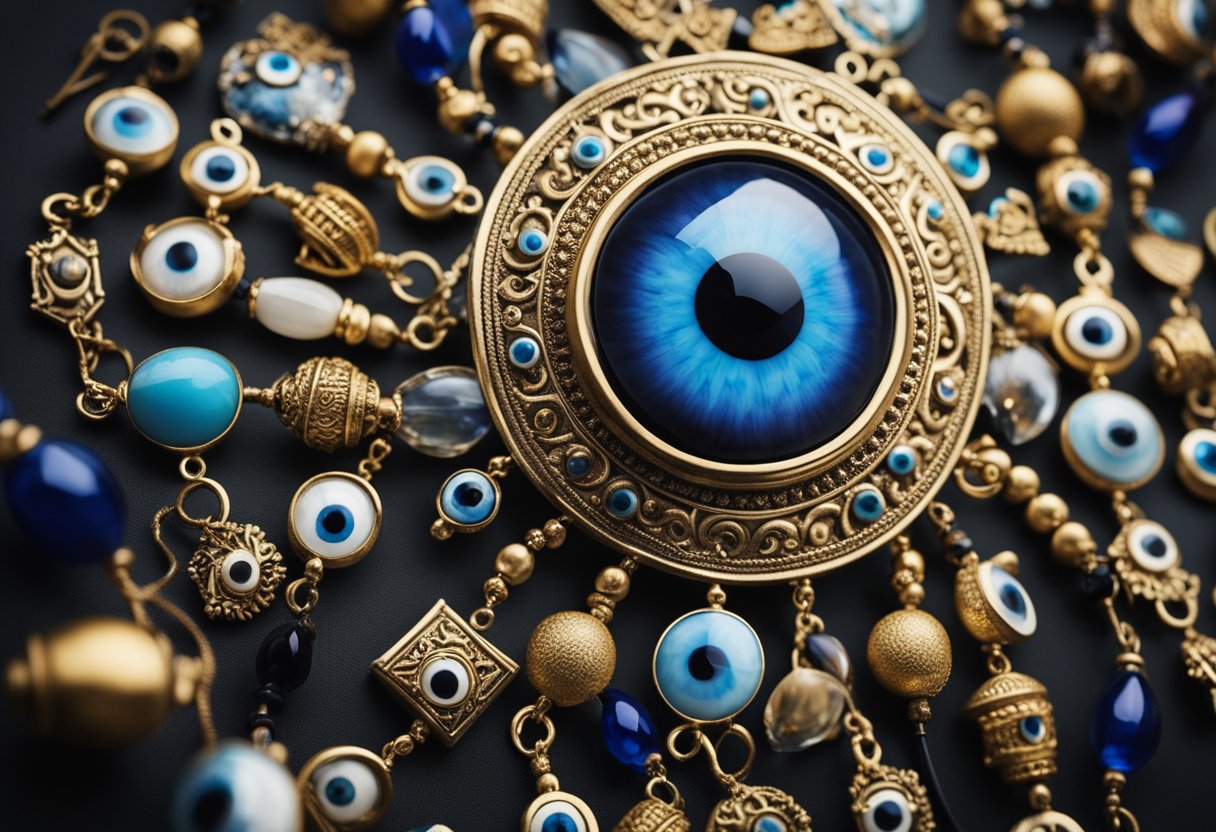
Updated On: March 13, 2024 by Eman Sameh
Throughout history, various cultures have been tied together by a common thread—the belief in the malevolent force of the evil eye. This deep-rooted concept spans continents and epochs, serving as a testament to humanity’s shared concerns over envy and misfortune. Numerous societies maintain the conviction that malevolence can be transmitted through a spiteful gaze, leading to illness, misfortune, or even death. These manifestations of the evil eye, while sharing core similarities, exhibit unique characteristics that are intricately woven into the cultural fabric of each society.
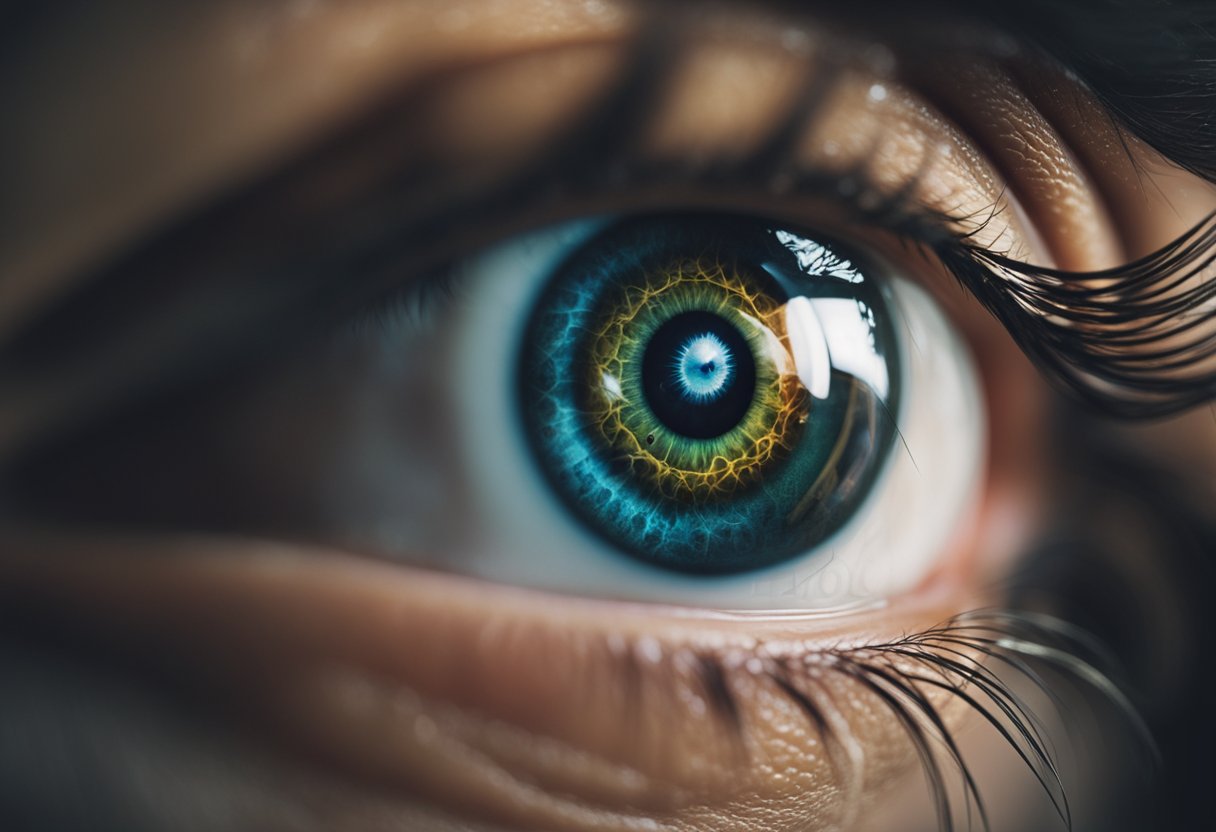
The historical origins of the evil eye myth can be traced back to ancient civilizations, where it is frequently mentioned in classical literature and artefacts. The interpretations and responses to this malevolent gaze have diversified over time, leading to a rich tapestry of symbols and countermeasures. Protective amulets and charms, for instance, have been employed across various cultures as a barrier against the evil eye’s potency. These practices, deeply entrenched in tradition and spirituality, have evolved but continue to play a significant role in many contemporary societies
Historical Origins Evil Eye Myth

This exploration of the evil eye myth’s historical origins focuses on the significance of its presence in ancient civilisations. The beliefs surrounding the malevolent glare that could bring misfortune or harm have deep roots in the cultures of Ancient Mesopotamia, Greece, Rome, and Egypt.
Ancient Mesopotamia
In Ancient Mesopotamia, the evil eye was more than a superstition; it was a pervasive fear in the everyday lives of the people. Artefacts from this era often display images meant to ward off evil spirits. These included depicting figures with hands raised in a gesture of protection or eyes exaggerated to counteract the evil gaze. This demonstrates not only a belief in the potent power of the malevolent gaze but also a culture steeped in practices to repel its effects.
Greek and Roman Perspectives
The ancient Greeks and Romans had a similar fear of the evil eye. To them, envy was the usual source of this maleficent force. They took measures to protect themselves using amulets and talismans, often in the form of an eye—a practice that has survived in various forms to this day. In particular, the Greek term “mati” pertains to the evil eye, a concept extensively documented in their literature and artefacts.
Egyptian Influence
The Egyptians contributed to the evil eye myth with their iconic symbol, the Eye of Horus. This symbol, which straddles the line between the physical and metaphysical, served as a symbol of protection and healing, representing royal power and good health. It showcases our ancient desire for protection against unseen forces, with the eye symbol becoming a talisman used to deflect harm in many cultures following Egyptian influence.
Cultural Variations and Beliefs
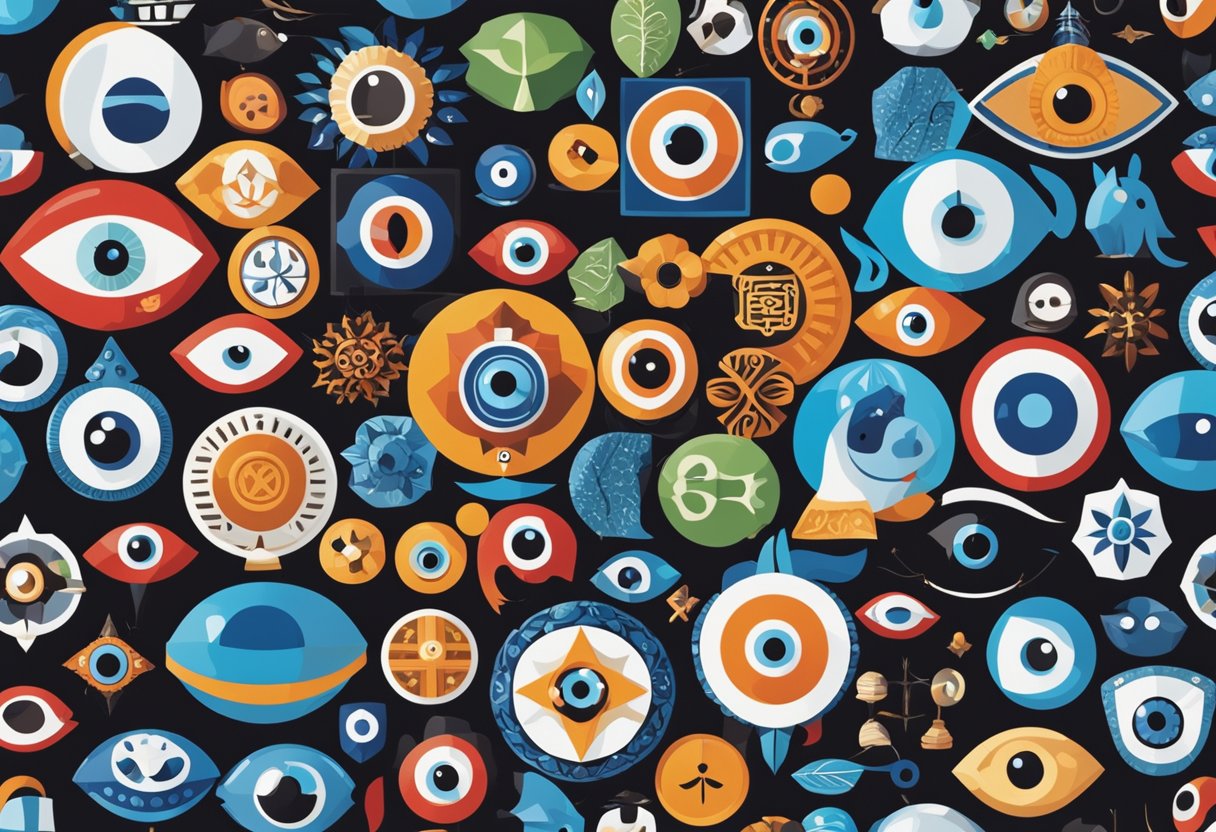
Across the globe, the malevolent glare known commonly as the evil eye is not just a simple superstition but rather a belief embedded in the cultural fabric of various societies. It speaks volumes about the human psyche and the shared concerns amongst different communities regarding envy and malevolence.
Mediterranean Traditions
In the Mediterranean, the concept of the evil eye is steeped in a rich tapestry of history and cultural nuance. It is particularly prevalent in countries like Greece and Turkey, where wearing a nazar—an eye-shaped amulet typically made of blue and white glass—is a widespread practice. This amulet represents the protective gaze that wards off the harmful intent of the evil eye.
- Greece: In Greek culture, the evil eye is known as mati, and it is believed that it can be cast upon someone through a malevolent glare, often powered by jealousy.
- Turkey: Turkish tradition strongly believes in the power of the nazar. It’s commonly seen hanging in homes and offices and in jewellery, symbolising protection and bringing good luck to the bearer.
European Superstitions
Moving through Europe, we encounter a myriad of beliefs surrounding the evil eye. Superstition runs deep, influenced by the intertwining of religious teachings with local folklore.
- Christianity: Within some Christian communities, the evil eye is regarded as a threat, and various prayers and rituals have been adopted to shield one from harm. In some regions, the sign of the cross is made to protect against it.
- Islam: Similarly, in Islamic tradition, the evil eye is taken seriously, where it’s thought that envy can bring about real-world misfortune. The saying of Mashallah, meaning ‘God has willed it’, is often used to ward off its effects.
Asian Perspectives
In Asia, the belief in the evil eye takes a different shade, intertwined with the unique spiritual and cultural frameworks of the region.
- India: The evil eye, or nazar, as it’s known locally, is deeply rooted in Indian beliefs. Various charms and rituals, such as using black dots on children, are common practices to avert its malevolent influences.
- Hindu: In Hindu tradition, godly figures such as Lord Shiva are entreated to protect against the evil eye, with many spiritual and physical remedies like the use of charms and amulets employed for this purpose.
Symbolism and Representation
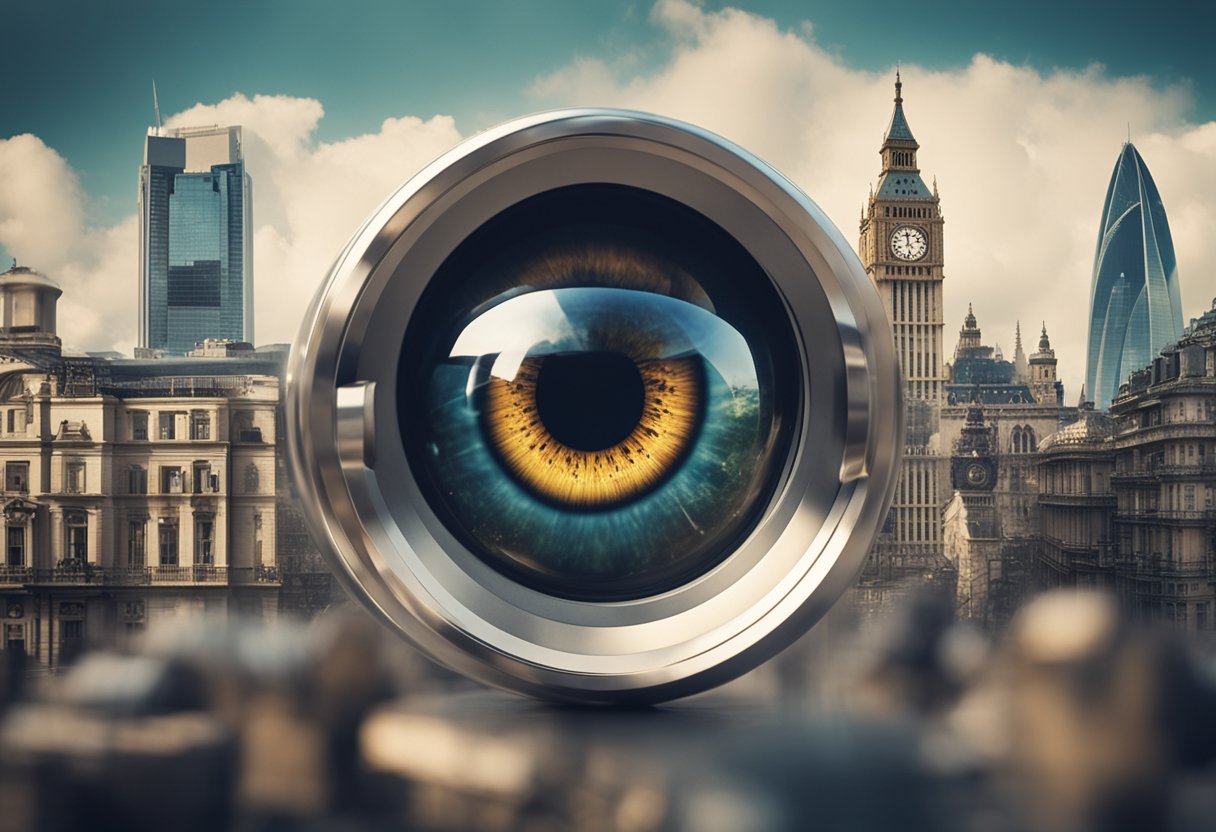
In various cultures, symbols carry profound meanings and the evil eye is no exception, often represented through imagery of eyes and specific colours that convey its protective essence.
Eyes as Symbols
Eye of Horus: Ancient Egyptians believed that this symbol provided protection, health, and rejuvenation. For them, the eye recovered by Horus embodied restoration, healing, and sacrifice. The symbol is prevalent in many artefacts and is intertwined with mythology and power.
Evil Eye Bead: A common representation found across cultures, the evil eye bead is thought to safeguard against malevolent glances. It traditionally features concentric circles or teardrop shapes, with blue being the most significant colour. This bead is evident in jewellery, amulets, and other adornments that reflect or ward off the supposed curse.
Blue Eye Symbol: Predominant in the Mediterranean and West Asia, the blue eye symbol on talismans or charms is widely recognised for its protective powers against the evil stare, which is said to deflect bad fortune.
Colours and Their Meanings
- Blue: Often associated with the sky and sea, blue symbolises truth, tranquillity, and protection in the context of the evil eye.
- White: Representing purity and light, white within the evil eye symbol can signify cleanliness and new beginnings.
- Dark Blue: A common colour for the evil eye bead, dark blue signifies good karma and positive energies.
Table: Significance of Colours in Evil Eye Symbolism
| Colour | Meaning |
|---|---|
| Blue | Protection, Truth |
| White | Purity, New Beginnings |
| Dark Blue | Positive Energy, Good Karma |
Throughout history, the evil eye has been a powerful symbol across different civilisations, signifying protection and warding off harm. The symbols and colours embedded in this mythos carry distinct meanings that have been cherished and feared, forming an integral part of the cultural fabric that connects our diverse heritages.
Protective Amulets and Talismans
Throughout history, various cultures have developed unique amulets and talismans to protect themselves against the evil eye—a malevolent glare believed to harm those it is directed towards. These objects serve as a charm for protection, each with its own symbolic significance and material form.
From the Khamsa to Nazar
The Khamsa is a widely recognised symbol across the Middle East and North Africa, often seen in jewellery and wall hangings. Its open right-hand design is thought to ward off the evil eye and bring good fortune. The Khamsa frequently incorporates an eye symbol in its palm, combining two protective motifs into one powerful amulet.
The Nazar, a cobalt-blue bead resembling an eye, is prominent in countries like Turkey and Greece. Believed to reflect the evil intent back to the onlooker, it serves as a proactive shield. The term ‘nazar’ itself translates to ‘sight’ or ‘seeing’ in Arabic, underpinning its association with visual protection.
Jewelry and Decorative Objects
Jewellery serves not only as adornment but also as a carrier for amulets and charms. Often fashioned from materials like silver or gold and enhanced with gemstones, these pieces are designed to be worn daily, offering continuous protection.
Decorative objects are equally important. From carvings hung above doorways to intricate tapestries adorning homes, these objects integrate talismans like the evil eye amulet into daily life. The presence of these items is a constant reminder of the cultural significance of protection and the enduring belief in the power of talismans to bring safety and ward off harm.
Social and Psychological Aspects

The evil eye stands out as a compelling example of how social beliefs intertwine with human emotions within the myriad of cultural narratives. Central to this are envy and jealousy, often invoked as the catalysts for the curse.
Envy and Jealousy
Envy, the resentful longing provoked by someone else’s possessions or qualities, is a common emotion at the heart of the evil eye myth. This powerful feeling can translate into a malevolent glare, believed to cast misfortune or harm upon the recipient. Unlike mere covetousness, envy is laden with ill will, distinguishing it as a pivotal emotion in this cultural phenomenon.
Success and Misfortune
Success and good fortune, while celebrated achievements, can paradoxically attract bad luck in the form of an evil eye. The dichotomy is palpable: the very symbols of achievement can become magnets for jealousy and curse. It’s a social reflex where the well-being of one can become the seed of another’s ill will, manifesting as a desire to balance the scales, even through harm.
Folklore and the Evil Eye
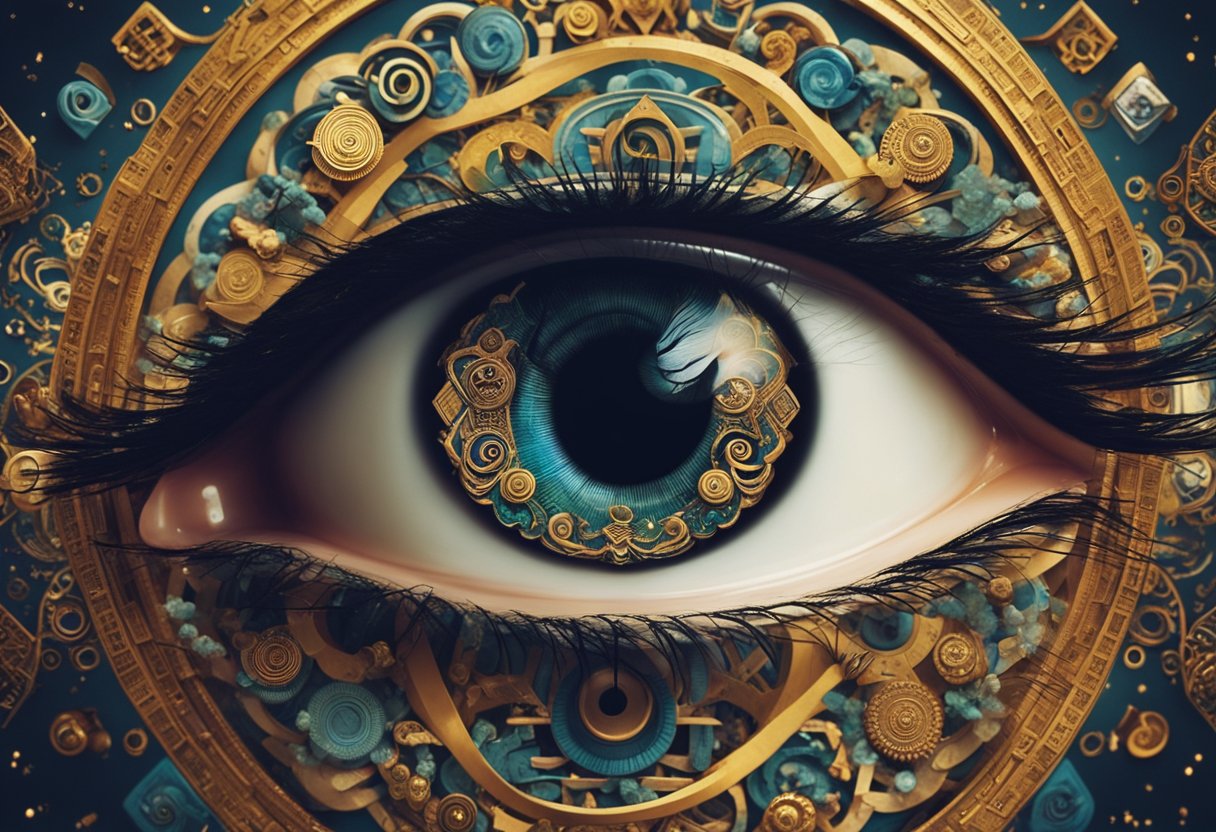
The concept of the evil eye is a prevalent theme within folklore, associated with a curse that is believed to be cast by a malevolent stare, often stemming from envy.
Witches and Sorcery
In many tales, witches are closely linked with the casting of the evil eye; seen as masters of the dark arts, these figures are often depicted as having the power to inflict injury or misfortune upon unsuspecting victims. Gestures or specific artefacts are sometimes credited with the ability to ward off the negative energy projected by a witch’s glare.
Tales and Narratives
Folklore worldwide brims with narratives focusing on the consequences of receiving the evil eye and the superstitions surrounding its avoidance. These tales often reflect cultural nuances that define what is considered malevolent, with sorcerers and ordinary individuals alike being imbued with the perilous ability to harm through looks that espouse jealousy or disdain.
Modern Interpretations and Uses
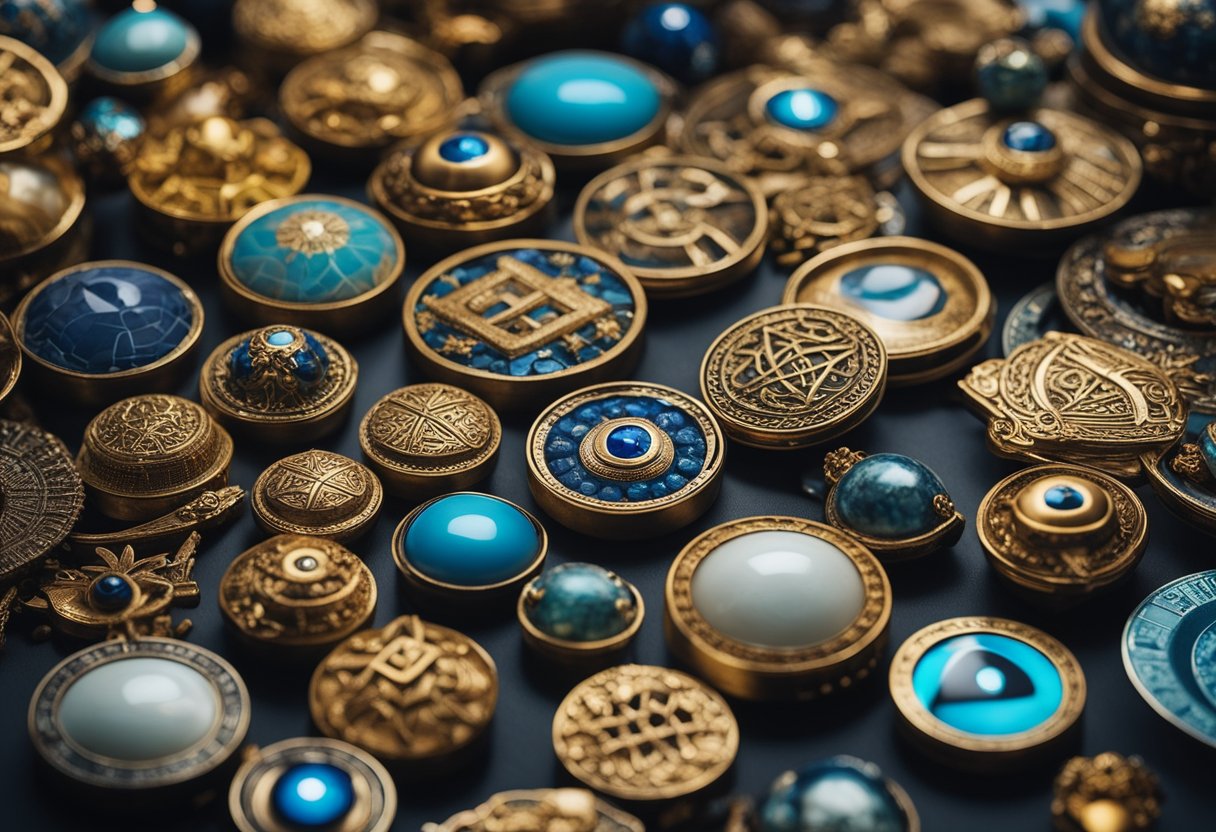
In modern times, the ancient symbol of the evil eye has taken on new life, particularly in the realms of fashion and among public figures. It’s no longer just a talisman for protection; it’s a style statement blending the allure of mystique with contemporary aesthetics.
Fashion and Aesthetics
The evil eye motif has seen a resurgence in the fashion industry, often appearing as a featured design in jewellery, clothing, and accessories. Designers have reimagined the traditional nazar amulet—a glass bead believed to protect against the evil eye—into modern fashion pieces that combine cultural heritage with a touch of style. It’s not uncommon to find the evil eye adorning items such as bracelets, necklaces, and even swimwear, often in bold colours and with intricate detailing.
Brands have embraced this symbol, crafting collections that reflect a blend of cultural respect and modern charm. High-fashion runways and high-street stores alike are showcasing the evil eye in various forms, making this protective icon a trendy and sought-after element in contemporary wardrobes.
Celebrities and Public Figures
Celebrities have played a considerable role in the popularisation of the evil eye in contemporary culture. They’re frequently spotted wearing evil eye jewellery, which has contributed to its status as a fashionable accessory. Public figures, from actors to influencers, have been seen sporting the symbol at events or on social media, thus introducing it to new audiences.
Their endorsement has helped transform the evil eye into a global signifier of both protection and fashion-forward sensibility. As these public personas are often emulated for their style choices, the influence they wield has significantly impacted how the evil eye is perceived and utilised today.
Taking inspiration from the rich cultural heritage that the evil eye represents, we can observe how it has traversed from its protective origins to become a ubiquitous component of modern fashion and public life.
Prevention and Countermeasures
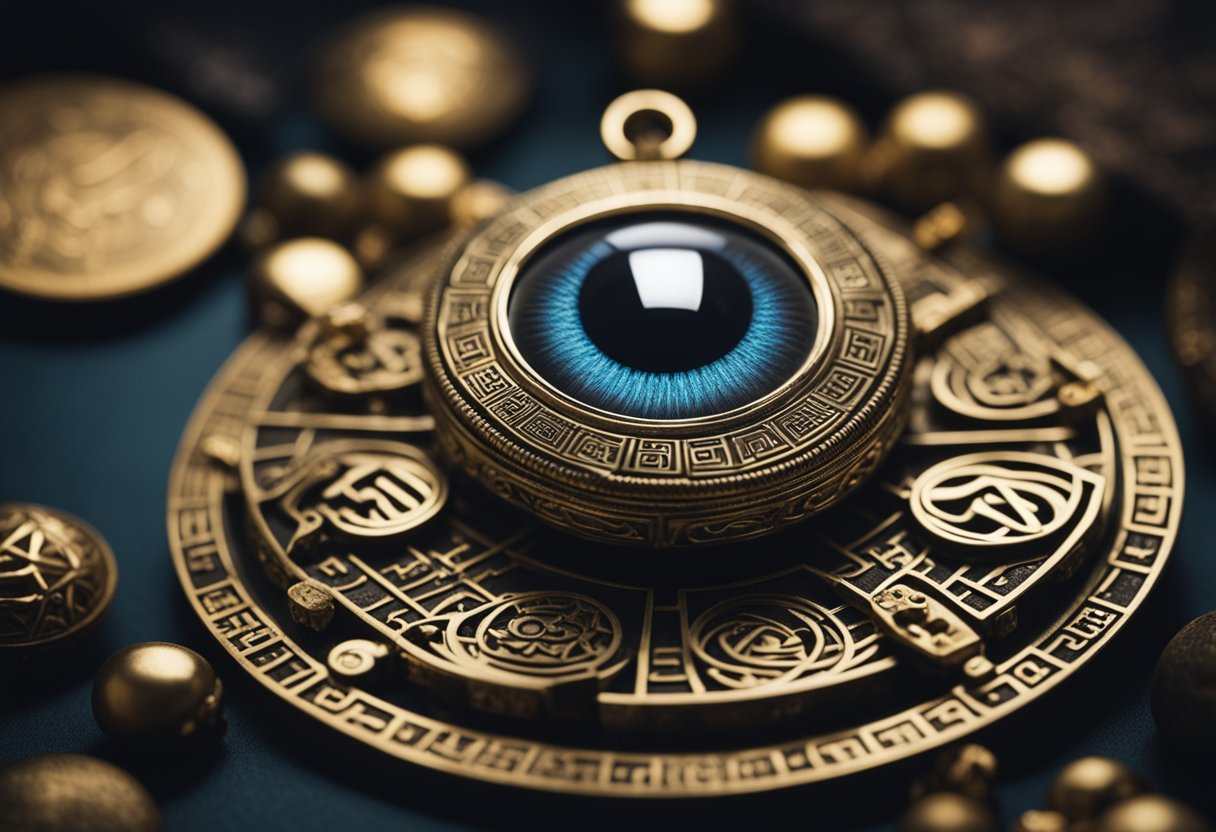
In combating the ill effects of the evil eye, various cultures have developed specific rituals and employ certain objects believed to offer protection and success.
Rituals and Practices
Many cultures have designed rituals to shield against the evil eye. These often include the chanting of prayers, the use of protective hand gestures, or the performance of elaborate ceremonies. Among these, the act of painting the eyelids to ward off curses can be found, as can specific bathing rituals intended for children, who are considered especially vulnerable.
Objects and Plants
Historically, various objects and plants have served as amulets and talismans to counteract the evil eye. Jewellery has played a significant role here, with items such as necklaces, bracelets, and pendants bearing symbols like the eye-shaped nazar in countries like Turkey. Likewise, garlic has been hung in homes or carried in pockets around the Mediterranean as it’s believed to offer protection.
| Object/Plant | Use |
|---|---|
| Nazar amulets | Worn as jewellery or hung in homes |
| Garlic | Hung in homes or carried on one’s person |
| Turquoise | Used in jewellery to repel curses |
| Red ribbons | Tied on cribs or clothing for children |
By understanding and respecting these practices and objects across different cultures, we strengthen our appreciation for the global tapestry of belief and protection.
The Evil Eye in Religion and Spirituality
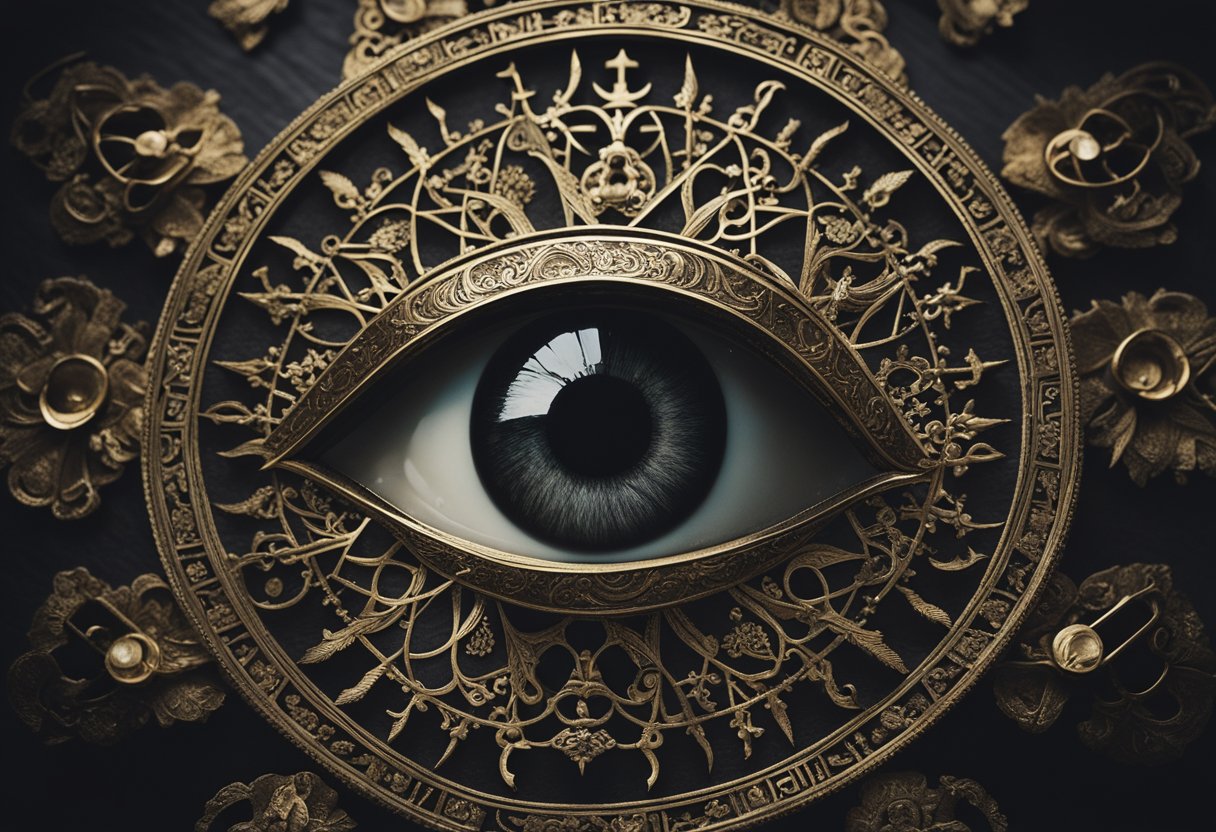
The belief in the Evil Eye spans across various religions and spiritual teachings, each attributing different meanings and defenses to this malevolent glare.
Judaism and Christianity
In both Judaism and Christianity, the Evil Eye is often viewed as a form of envy or ill will that one person can direct towards another. This negative energy is believed to have the potential to cause harm. For example, in the Bible, specifically in the Book of Proverbs, the evil eye is something to be guarded against due to its association with stinginess and a lack of compassion.
Islamic Teachings
Within Islamic culture, the Evil Eye, or ‘al-ayn’, is a commonly acknowledged spiritual concern. The faithful employ various duas and prayers to seek protection from Allah against the harm of the Evil Eye. It is considered a valid fear, and prophetic traditions recommend supplications that invoke God’s protection from its effects.
Hinduism and Beyond
Stepping beyond the Abrahamic traditions, in Hinduism, the Evil Eye is known as ‘drishti’ or ‘Nazar‘. It’s a spiritual obstacle that can impact individuals and their possessions. To counteract the Evil Eye, rituals such as the ‘nazar utarna’ are performed. This belief system extends into other spiritual beliefs found throughout Southeast Asia and beyond, where it melds with indigenous and local customs.
Evil Eye in Modern Healthcare
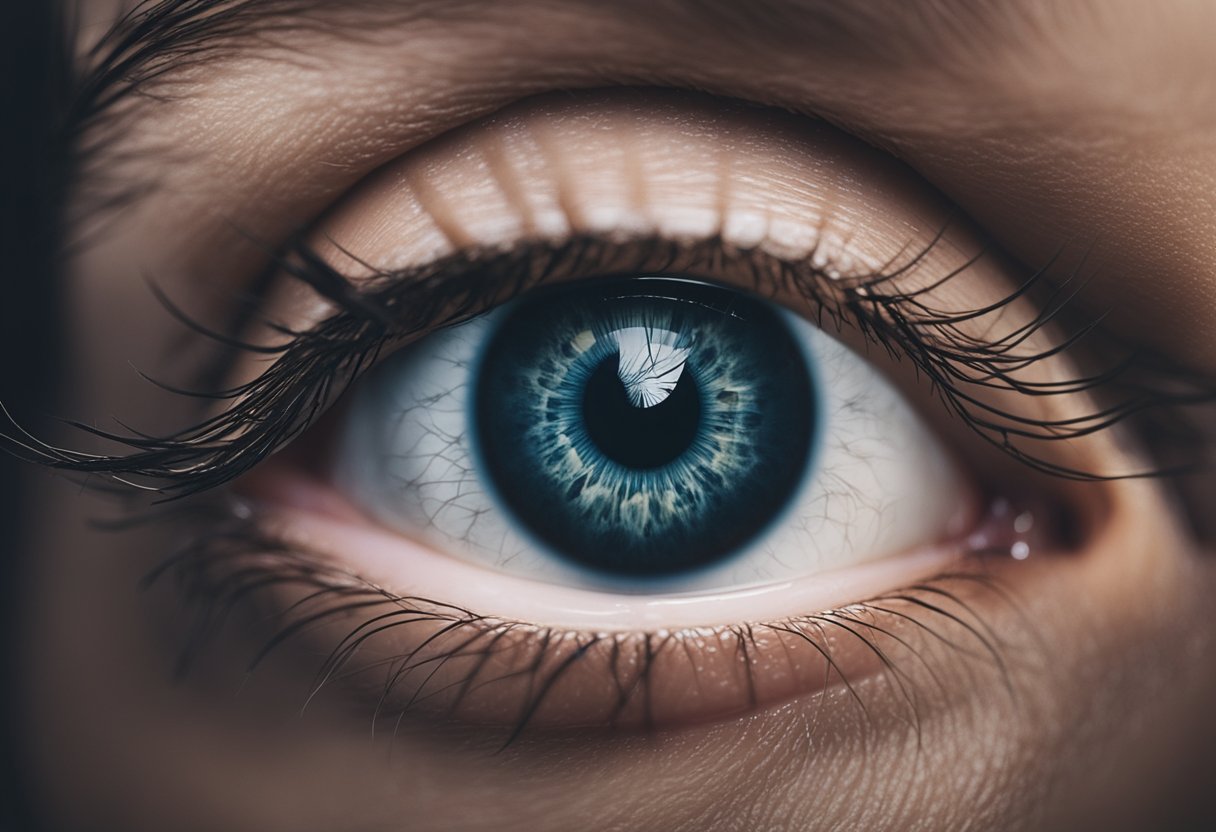
In this section, we explore the enduring belief in the evil eye within modern healthcare settings, particularly considering its psychological impact and intersection with traditional medicine.
Psychological Considerations
The concept of the evil eye continues to affect individuals psychologically, particularly in the Mediterranean region. It is often linked with the onset of stress-related symptoms, which suggests that the fear of being afflicted by the evil eye can lead to anxiety and nervousness. In some cultures, the evil eye is believed to cause harm to children and newborns, heightening parental concern for the well-being of their offspring.
Traditional Medicine
Within traditional medicine, the evil eye is often cited as a cause of illness or injury. Ancient remedies and cures for the evil eye are still prevalent, especially in rural areas where conventional healthcare may not be readily accessible. Various traditional practices, such as using amulets or performing rituals, are thought to ward off the evil eye and protect against disease. These customs are particularly significant when dealing with vulnerable populations such as newborns, where traditional ceremonies are performed to safeguard them from harm.
Frequently Asked Questions

We will address the most common enquiries surrounding the intriguing topic of the evil eye—a belief firmly rooted in cultures worldwide, encompassing varying interpretations and protective measures.
What are the common beliefs associated with the evil eye across various cultures?
The evil eye is universally recognised as a malevolent glare believed to cause harm or bad luck. Cultures attribute this curse to jealousy or spite, often towards individuals with prosperity or beauty. The apprehension surrounding such pernicious stares has led to a mosaic of beliefs and superstitions.
How do people protect themselves from the evil eye in different parts of the world?
Various amulets and rituals exist globally to ward off the evil eye’s effects. In Mediterranean regions, individuals wear charms like the blue and white Nazar. Other cultures use hand gestures, talismans, or religious texts for protection. These practices reflect a rich tapestry of traditional methods and symbolism.
In what ways does the Indian interpretation of the evil eye differ from other countries?
In India, the evil eye, known as ‘drishti’ or ‘nazar’, is a prevalent concern, and its countermeasures are deeply interwoven within the social fabric. Remedies range from applying kohl on infants to using ‘nazar battus’—black dots to distract the gaze. These distinctive customs embody India’s unique perspective on this age-old superstition.
From which region did the concept of the evil eye originally emerge?
Historical evidence suggests that the concept of the evil eye originated in the ancient civilisations of Mesopotamia, Egypt, and Greece. It has been a pervasive element in folklore and societal norms over millennia, exhibiting its staying power and wide-reaching influence across societies.
What significance do the colours and designs of evil eye amulets hold?
The hues and patterns seen on Evil Eye amulets are not just decorative; they carry significant symbolism. Blue commonly represents truth and wards off negative energy, while specific shapes like the eye are intended to reflect harm back to its origin. These designs collectively serve as a repository of cultural significance and protective intent.
Can anyone adopt the use of the evil eye talismans, regardless of their cultural background?
Absolutely, the use of evil eye talismans transcends cultural boundaries. People around the world are drawn to their alleged protective capabilities and aesthetic appeal. While respecting the origins and traditions tied to these symbols is paramount, embracing them as universal protectors has been commonly accepted across diverse cultures.



